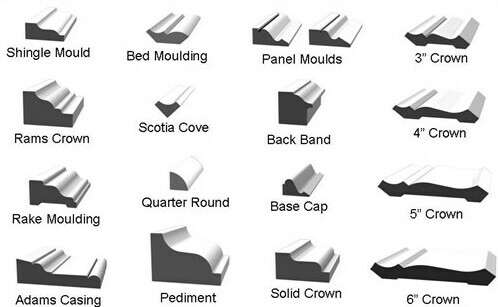Welcome to the ultimate guide on decorative moulding profiles! As someone who’s spent years transforming spaces with these delightful architectural elements, I’m excited to share insights, tips, and personal experiences to help you understand their significance and how they can elevate your home decor. Whether you’re a homeowner, an interior designer, or just curious about decorative mouldings, this article is packed with valuable information that caters to all enthusiasts.
What is Decorative Moulding?
Decorative moulding refers to ornamental trim that adds character and detail to various structures in a home. From ceilings to walls, doors to windows, moulding can be added in various forms, enhancing aesthetics while providing a polished finish.
Types of Decorative Moulding Profiles
There are numerous styles and profiles of decorative moulding available. Understanding these can help in making an informed choice that suits your design aesthetic.
Crown Moulding
Crown moulding is perhaps the most recognized form of decorative moulding. It is used to create a seamless transition between the wall and the ceiling.
Pros and Cons of Crown Moulding
| Pros | Cons |
|---|---|
| Adds elegance and height to a room | Can be expensive to install |
| Variety of styles available | Requires precise cutting and installation |

Baseboards
Baseboards are installed at the junction of the wall and floor. They serve both functional and aesthetic purposes, protecting the walls from damage while enhancing the overall design.
Pros and Cons of Baseboards
| Pros | Cons |
|---|---|
| Protects walls from scuffs and marks | May require regular maintenance |
| Available in various heights and styles | Installation can be labor-intensive |

Chair Rails
Chair rails run horizontally along the wall and are typically installed about one-third of the way up from the floor. They are great for dividing wall colors or wallpaper.
Pros and Cons of Chair Rails
| Pros | Cons |
|---|---|
| Creates visual interest in the room | Not always necessary in modern design |
| Can protect walls from furniture damage | Requires careful measurement for installation |

Window and Door Casings
Casings frame windows and doors, enhancing their visual appeal and providing a finished look.
Pros and Cons of Window and Door Casings
| Pros | Cons |
|---|---|
| Enhances architectural detail | Can be costly depending on material |
| Available in styles ranging from traditional to modern | Installation can be complex |

Materials Used in Decorative Moulding Profiles
The material you choose for your moulding can impact not only the look but also the durability and maintenance of the moulding.
Wood Mouldings
Wood mouldings are classic and versatile, offering a warm and natural look. They can be stained or painted to match your decor.

Polyurethane Mouldings
Polyurethane is lightweight and resistant to moisture, making it an excellent choice for areas prone to humidity. It can mimic the look of wood without the associated maintenance.
MDF Mouldings
Medium Density Fiberboard (MDF) mouldings are often the most affordable option. They are easy to paint, making them a popular choice for custom designs.

Plaster Mouldings
For a truly traditional and high-end look, plaster mouldings can add incredible detail. However, they are heavier and more costly than other options.
How to Choose the Right Moulding Profile for Your Space
Selecting the right moulding can seem daunting with so many options. Here are some key factors to consider:
Understand Your Style
Are you drawn to modern, minimalist designs or more traditional, ornate styles? Your selection should align with the overall theme of your home.
Room Dimensions
Large spaces can handle wider and more elaborate mouldings, while smaller rooms may benefit from simpler profiles to avoid overwhelming the space.
Color and Material Coordination
The moulding should complement the colors and materials used in the room. For instance, a dark wooden moulding contrasts beautifully against light-colored walls.
Installation Tips for Decorative Moulding
Whether you’re a DIY enthusiast or hiring a professional, here are some tips that might help:
Preparation is Key
Measure all spaces accurately and have everything needed for installation, including tools and materials, ready beforehand.
Use the Right Tools
A miter saw is essential for angled cuts, while a nail gun helps speed up the installation process.
Practice Patience
Take your time with cuts and fit to ensure everything lines up perfectly. A rushed job can lead to mistakes that are costly to fix.
Common Mistakes to Avoid
Stepping into the world of decorative moulding can be tricky. Here are some things to watch out for:
Not Planning Ahead
Failing to measure and plan can lead to unnecessary waste and frustration. Always double-check your measurements!
Ignoring the Ceiling Height
The height of your ceilings should influence your moulding choice. Tall ceilings can showcase larger profiles beautifully, while lower ceilings may require more subtle options.
FAQs about Decorative Moulding Profiles
What is the most popular type of decorative moulding?
Crown moulding is widely regarded as the most popular choice due to its ability to enhance architectural beauty by connecting walls to ceilings.
Can I install moulding myself?
Yes, with the right tools and some patience, many homeowners choose to install moulding themselves. However, professional installation ensures precision.
How do I maintain my decorative moulding?
Regular dusting and occasional painting or refinishing will keep your moulding looking fresh and new. Avoid harsh chemicals that might damage the finish.
Is decorative moulding worth the investment?
Absolutely! Decorative moulding not only enhances aesthetic appeal but can also increase property value, making it a worthy investment for homeowners.
Conclusion
Decorative moulding profiles can transform your home into a stunning sanctuary filled with character and style. By understanding the different types, materials, and installation techniques, you can make informed choices that enhance your space. Whether you opt for classic crown moulding or chic baseboards, remember that the right moulding elevates your home’s charm.
So, go ahead and unleash your creativity! Your home deserves the best, and with decorative mouldings, you can achieve the beautiful, bespoke look you’ve always dreamed of.